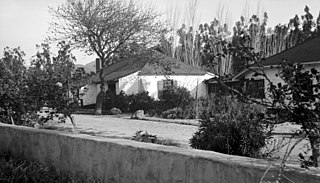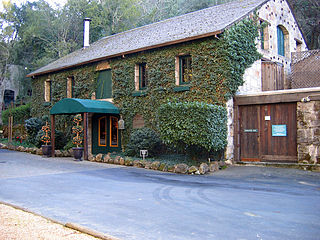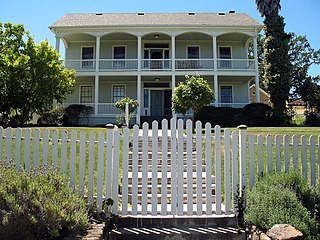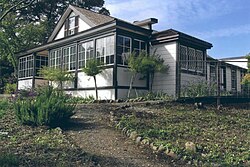
John Griffith Chaney, better known as Jack London, was an American novelist, journalist and activist. A pioneer of commercial fiction and American magazines, he was one of the first American authors to become an international celebrity and earn a large fortune from writing. He was also an innovator in the genre that would later become known as science fiction.

Glen Ellen is a census-designated place (CDP) in Sonoma Valley, Sonoma County, California, United States. The population was 784 at the 2010 census, down from 992 at the 2000 census. Glen Ellen is the location of Jack London State Historic Park, Sonoma Valley Regional Park, and a former home of Hunter S. Thompson.

The Little Lady of the Big House (1915) is a novel by American writer Jack London. It was his last novel to be published during his lifetime.

Sonoma Valley is a valley located in southeastern Sonoma County, California, in the North Bay region of the San Francisco Bay Area. Known as the birthplace of the California wine industry, the valley is home to some of the earliest vineyards and wineries in the state, some of which survived the phylloxera epidemic of the 1870s and the impact of prohibition in the early 20th century. Today, the valley's wines are promoted by the U.S. federal government's Sonoma Valley and Carneros AVAs.

Rancho Camulos, now known as Rancho Camulos Museum, is a ranch located in the Santa Clara River Valley 2.2 miles (3.5 km) east of Piru, California and just north of the Santa Clara River, in Ventura County, California. It was the home of Ygnacio del Valle, a Californio alcalde of the Pueblo de Los Angeles in the 19th century and later elected member of the California State Assembly. The ranch was known as the Home of Ramona because it was widely believed to have been the setting of the popular 1884 novel Ramona by Helen Hunt Jackson. The novel helped to raise awareness about the Californio lifestyle and romanticized "the mission and rancho era of California history."

Joan London was an American writer and the older of two daughters born to Jack London and his first wife, Elizabeth "Bess" Maddern London.

Kenwood is an unincorporated community and census-designated place (CDP) in Sonoma County, California, located on Sonoma Highway between the cities of Santa Rosa and Sonoma. It lies east of Sonoma Creek in the upper part of Sonoma Valley, a region sometimes called the Valley of the Moon. Bennett Mountain lies west of the town, and Sugarloaf Ridge to the northeast. The population was 1,028 at the 2010 census.

Charmian London was an American writer and the second wife of Jack London.

Rancho Petaluma Adobe is a historic ranch house in Sonoma County, California. It was built from adobe bricks in 1836 by order of Mariano Guadalupe Vallejo. It was the largest privately owned adobe structure built in California and is the largest example of the Monterey Colonial style of architecture in the United States. A section of the former ranch has been preserved by the Petaluma Adobe State Historic Park and it is both a California Historic Landmark and a National Historic Landmark. The Rancho Petaluma Adobe State Historic Park is located on Adobe Road on the east side of the present-day town of Petaluma, California.

Sonoma Mountain is a prominent landform within the Sonoma Mountains of southern Sonoma County, California. At an elevation of 2,463 ft (751 m), Sonoma Mountain offers expansive views of the Pacific Ocean to the west and the Sonoma Valley to the east. In fact, the viticultural area extends in isolated patches up the eastern slopes of Sonoma Mountain to almost 1,700 feet (520 m) in elevation.
Albert L. Farr was an American residential architect who designed homes in the Craftsman and Georgian styles.

The Mountain Winery, formerly the Paul Masson Mountain Winery, is a winery in Saratoga, California, United States, North America. It was founded by Paul Masson, a pioneer of the California wine industry. The winery became famous for its slogan, voiced by Orson Welles in television commercials: "We will sell no wine before its time."

Buena Vista Winery is a winery located in Sonoma, California, United States. It is the second oldest winery in California after the D'Agostini Winery, which was founded a year prior in 1856. It was founded by Agoston Haraszthy in 1857. The winery is located on its original grounds, just east of Sonoma, California.
Rancho Los Guilicos was a 18,834-acre (76.22 km2) Mexican land grant in present-day Sonoma County, California given in 1837 by Governor Juan B. Alvarado to John (Juan) Wilson. The grant extended along Sonoma Creek, south of Santa Rosa from Santa Rosa Creek south to almost Glen Ellen, and encompassed present day Oakmont, Kenwood and Annadel State Park.

The Nicholas Carriger Estate (16-acre) is a collection of buildings located in Sonoma, California, United States. The estate consists of three buildings: the main house built in 1847, a small house, which is a replica of the main house, built in 1860, and a winery, built in 1875. The main house and the Little Carriger house fall in the architectural Greek revival style. There also is a locally quarried "candy rock" stone small building next to the main house that may have been used as an ice house. The everflowing Yulupa Spring, which supplied water to the houses and is still flowing, is a short walk along a hillside pathway from the main house. In 1979 the estate was designated a Sonoma County Historic Landmark, and in 2001, it was added to the National Register of Historic Places.
The Valley of the Moon Natural History Association (VMNHA) is a 501(c)(3) Non-Profit Organization based in Sonoma County, CA which cares for the Jack London, Annadel and Sugarloaf Ridge State Parks.

Wolf House was a 26-room mansion in Glen Ellen, California, built by novelist Jack London and his wife Charmian London. The house burned on August 22, 1913, shortly before the Londons were planning to move in. Stone ruins of the never-occupied home still stand, and are part of Jack London State Historic Park, which has been a National Historic Landmark since 1963.

Kenwood Vineyards is a winery in Kenwood, California, located on Highway 12 in the Sonoma Valley wine country. It is currently owned by Pernod Ricard Winemakers.

Netta Eames was born Ninetta Wiley, in Wisconsin on September 26, 1852. She is commonly known as Netta. She is best known as a writer and magazine editor in the late 1800s and early 1900s. As the editor of the San Francisco based Overland Monthly magazine, she became an early proponent of Jack London as a writer. She was the first to publish one of his short stories, "To the Man on Trail", in 1899, and wrote a promotional biography of London in Overland Monthly in 1900, which helped to establish his career. Later she was his business manager and neighbor.

Walters Ranch Hop Kiln is historical site of buildings built in 1905, in Sonoma, California in Sonoma County, California. The Walters Ranch Hop Kiln is a California Historical Landmark No. 627 listed on January 13, 1958. The Walters Ranch Hop Kiln was built by Italian stonemason, Angelo "'Skinny" Soldini. Sol Walters purchased 380 acres of the Rancho Sotoyome, a 1853 Mexican land grant to Josefa Fitch. The Walters Ranch Hop Kiln is composed of three stone kilns for drying hops for 20 hours a patch. Hops are used in beer making breweries. In addition to the kilns, the site as a wooden building for cooling the hops and a two-story press for baling the hops for shipment. The Walters Ranch Hop Kilns was one of early and large operation in the Northern California region.
























